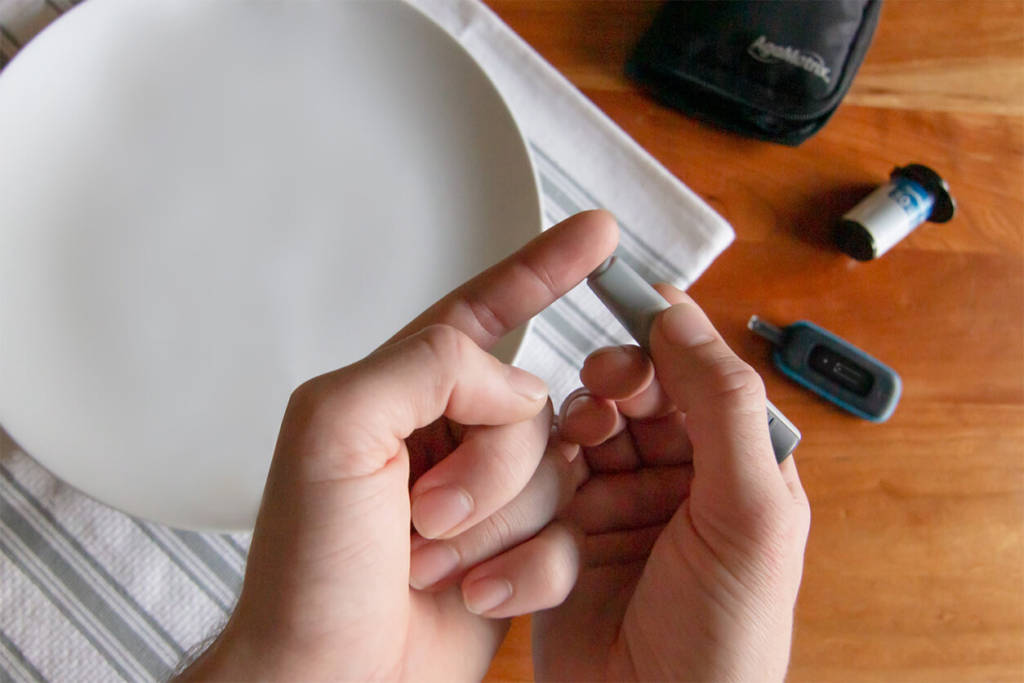Choosing the Best Glucose Meter for Your Needs [Complete Guide]
Reviewed by: Melissa Herrmann Dierks , RDN, LDN, CDCES![Choosing the Best Glucose Meter for Your Needs [Complete Guide]](https://agamatrix.com/wp-content/uploads/2019/02/BW2A4609-Edit_1200px.jpg)
If you have diabetes, regularly testing your blood glucose levels is an essential part of everyday life. Since making sure your levels are in a healthy range is a critical part of your overall wellbeing, choosing a blood glucose meter that is accurate and reliable is an absolute must.
With advancements in technology, there are now several options when it comes to testing your blood glucose levels:
- Monitors that use on-body sensors, like a continuous glucose monitor (CGM) measure glucose levels throughout the day. These include real time CGM (rtCGM) and intermittently scanned (isCGM) also known as flash glucose monitoring.
- Monitors which use a test strip with a drop of blood applied to measure blood glucose levels, also known as a blood glucose meter (BGM).
For the purpose of this article, we will focus on how to choose the right blood glucose meter for you. Here are 10 factors to consider:
- Accuracy
- Blood Sample Size
- Ease of Use
- Design/Form Factor
- No Coding
- Data Capabilities
- Connectivity
- Speed of Results
- Affordability: The Cost of Blood Glucose Meters & Test Strips
- Alternate Site Sampling
10 Blood Glucose Meter Factors to Consider
1. Accuracy
Your blood glucose readings will affect your insulin doses and treatment decisions, making accurate results from a reliable device crucial for your health.
Surprisingly, a recent study found that not all FDA-approved glucose meters meet accuracy standards. Of the top commercially available meters, a whopping 66% didn’t pass accuracy tests!
Since every glucose meter on the market has varying technology and accuracy performance, your blood glucose readings will likely fluctuate from one meter to another. You should pick one meter model, even if you keep meters at home, work, or on the go. Also, stick with that meter model for your daily management to ensure that you receive consistent readings for making treatment decisions.
There are also several factors that can affect accuracy:
- Variations in the proportion of red blood cells in your blood (your hematocrit)
- Environmental conditions (altitude, temperature)
- Manufacturing variability
To ensure that your device is reliable, make sure it utilizes the most innovative technology possible to detect and correct for these variations.
Learn more about meter accuracy in our article, The Truth Behind the Numbers: What Affects Blood Glucose Meter Accuracy?
2. Blood Sample Size
The larger blood sample a meter requires, the bigger the blood drop you will need to provide. This can cause difficulties if you have poor circulation or other health conditions, and can sometimes cause an increase in errors or wasted test strips if you can’t get a big enough blood drop.
Choosing a meter that only requires a tiny sample — such as 0.5 microliters or less — can be helpful and enable you to use a more comfortable lancing depth and lancet size.
If you plan on testing your glucose levels several times throughout the day, a lancet with a lower gauge (larger finger prick) might become painful. For frequent testing or to get a smaller drop of blood, you may able to use a lancet with a thinner needle (like these 33G lancets), which many people find to be less painful.
3. Ease of Use
If your blood glucose meter is too complicated, takes too long to read, or requires coding, you’ll be less likely to reach for the device when it’s time to test. And that defeats the entire purpose of the meter!
Choosing a simple blood glucose meter is the best motivation for testing as often as you need, so make sure you’re comfortable with the design and technology. Also, check if there are any helpful features — like testing reminders or hypoglycemic and hyperglycemic alarms — that will make your life easier.
4. Meter and Display Size
The design and form of your meter goes hand-in-hand with its functionality. Modern-day meters come in various shapes and sizes, so there’s definitely one that will suit your lifestyle.
Here are a few questions to ask yourself before you choose a meter:
- Would you prefer a compact meter for discreet, on-the-go testing or a larger device that’s easier to grip and hold?
- Are the numbers on the display large enough to read?
- Does the display make it easy to view results in dim lighting or at night?
5. No Coding
Some blood glucose meters require manual coding, which means inputting a code every time you start using a new pack of test strips. A meter that is “No Code” means it’s already calibrated, saving you an extra step in the testing process.
Most brands are migrating toward code-free technology, but there are still a few on the market that require it for calibration. It’s important to correctly match the code as an error could cause inaccurate readings. If you’d prefer a code-free device, make sure the one you choose clearly states that it’s “No Code.”
6. Data Capabilities
How do you want to maintain your readings? Do you prefer writing them down by hand every day or would storing them all on the meter be ideal?
Fortunately, today’s blood glucose meters offer a world of options. What you need to check is the memory size for the device you’re considering, since the amount of readings stored on the meter may vary between different models. Some can hold hundreds or thousands of readings as well as time and date stamps, while others might only be able to store a maximum of 100.
There are also meters that can keep track of averages by certain time periods (usually 14, 30, or 90-day intervals), the time of day, and mealtimes. This is a useful feature that automatically tracks glucose level averages, so you can have a big-picture view of your health patterns.
7. Connectivity
Traditional blood glucose meters have become very tech-savvy, with many offering Bluetooth® wireless connections allowing you to more easily capture, analyze, and share your readings. Some meters also have a data download feature that lets you transfer results through a data port.
There are mobile management apps that wirelessly connect a meter and smartphone to automatically sync and store your readings. Even if you don’t use a meter with connectivity capabilities, many mobile apps allow you to record your readings manually. This makes it easy to track your blood glucose, share readings with your family and/or physicians, and identify certain trends in your readings.
8. Test Time
Waiting an eternity for results — especially if you’re testing multiple times a day — is incredibly inconvenient. Meters will typically list their average testing time to give you an idea of how long you’re likely to wait. Most people find a test of 5-6 seconds or less to be ideal.
9. Affordability: The Cost of Blood Glucose Meters & Test Strips
The first and most important note about the affordability of a blood glucose meter is that the price will be a one-time cost, but test strips need to be purchased on an ongoing basis.
How Much Should a Blood Glucose Meter Cost?
The cost of a blood glucose meter will depend on its features. Less costly meters may not have a color screen or Bluetooth capabilities, while more expensive meters may include these advanced features. Whatever the capabilities, the meter should last for at least a few years.
Many major brands have free meter programs that offer an upgrade to the latest device at no cost, but there are certain qualifications you must meet.
Test Strips
Test strip costs will vary based on the amount you need and the brand. Typically, test strips are available in 25, 50, or 100 count boxes. The price of test strips will depend on the brand, and can range anywhere from less than $0.25 per test strip to over a dollar each.
The blood glucose meter you choose will require you to use test strips that are designed specifically for that meter, so check costs before you decide on a meter brand.
If you’re testing several times throughout the day, you’ll need more strips, so you should consider total daily test strip cost.
Health Insurance Coverage
The cost of a meter will also depend on whether you’re going through your health insurance. On average, copay costs are between $20 and $80. However, your insurance plan can dictate the brands that are covered by your plan, which can be limiting.
For people with diabetes, there are many resources and financial assistance programs available to help manage the cost of diabetes. You can see our overview of these options in our article, Resources & Financial Assistance Programs to Help with the Cost of Managing Diabetes.
It’s important to know that you don’t necessarily have to go through your insurance. Many meters are affordable enough to purchase outside of a prescription. Some even cost less and offer features and benefits that others may not.
10. Alternate Site Sampling
Some meters will let you collect a blood sample from other parts of your body in addition to your fingertip, like the palm of your hand, forearm, calf, or thigh. If you test a lot throughout the day, this can be a huge benefit that gives your fingers a much-needed break.
However, it’s important to note that test results from alternate sites are considered less accurate than testing using your fingertip. This is because of physiological differences in the circulation in these areas.
Be aware that some situations may not make alternate site testing feasible. You shouldn’t use alternate test sites to:
- Calibrate a continuous glucose monitor (CGM)
- Check for hypoglycemia or hyperglycemia
- Test your levels within 2 hours of eating, taking medication or insulin, or exercising
Always ask your doctor before you use alternative testing sites.
We recommend thoroughly evaluating all of the above factors before choosing a blood glucose meter. There are dozens of options out there, so you’re sure to find a meter that’s right for your unique lifestyle!
Want to Compare Meters?
Remember the accuracy study we mentioned? The AgaMatrix meter that was manufactured for CVS Pharmacy (the CVS Advanced Glucose Meter) was one of only six products to receive passing performance and the Diabetes Technology Society’s Seal of Approval!
You can use our meter comparison chart to find the one that would be best for you.





![Meal Planning for Diabetes: How to Optimize Your Diet [Free Meal Plan Chart]](https://agamatrix.com/wp-content/uploads/2019/08/Diabetes_Meal_Planning_Feature_Image.jpg)